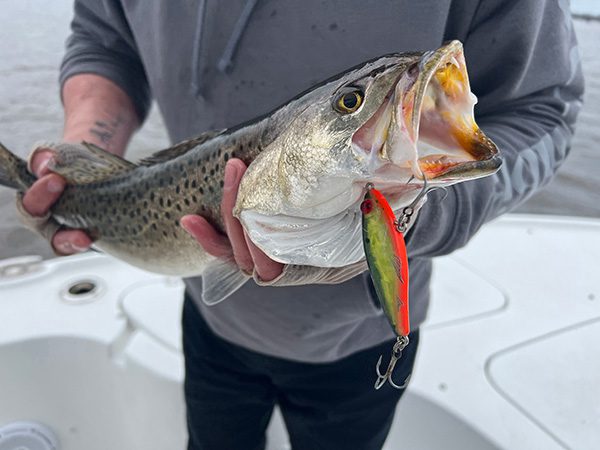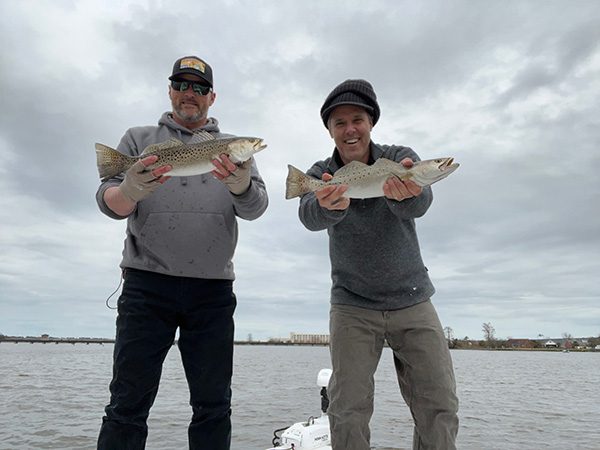Tidelines – March 2023
If you haven’t been on the water in a couple of weeks, how do you find your fish again? That was the question that faced Capt. Dana Tabarrini, of Reel2Reel Charters out of the New Bern area, when we met up on a chilly Sunday morning in February after he had been on vacation in Brevard.
“First, I look at my notes from the last 2-3 years,” Dana answered while we idled down a shoreline in Goose Creek. “I try to find a weather pattern that kinda matches and see where I was fishing on those days.”
His notes that include everything from weather patterns to water temperatures to barometric pressure, in addition to fish counts and baits thrown, suggested that Goose Creek would be a likely producer, and we were seeing plenty of signs of fish as we quietly made our way down the shoreline. Dana prefers the natural movement of a wind drift, so he was heading up the creek to get the wind at our backs.
We were seeing plenty of bait, including the topwater activity of bait flipping on the surface and small slicks, and fish were showing on his sidescan. I hopped up front, and Dana put a MirrOlure 17MR in my hand. The bait was a custom color, basically described as chartreuse with subtle pink sides and a dress treble on the back.
“I like the dress treble,” he told me, “as it gives the bait a plume that can resemble the tail of a fish. It’s one more piece of something to catch a fish’s eye”
Dana had confidence in the chartreuse and pink, he also explained, because our water was a little stained and the fish need something they can see, something that stands out. He believes in chartreuse, pinks, and purples, as well as hot olive and broken glass.
The 17MR falls at a rate of one foot per half second (roughly, as the fall rate also depends on current the amount of salt in the water), so Dana wanted me to give my MirrOlure 6-8 seconds of fall time since we were in a little more than 4-feet of water.
“You want that bait as close to the bottom as possible. Every time you pop that lure,” Dana demonstrated, “it’s going to move up the water column. That’s just physics. It’s coming up at you.”
I waited my 6-8 seconds, I popped, and I maintained a connection with the bait at all times, but apparently the trout we saw on Dana’s machine didn’t like what he or I was throwing. Even a trip down the other side of the creek, the side where the water is just a little bit deeper, only produced one blowup on Dana’s topwater and one missed bump on my hard bait.
This is the challenge that many guides face, especially with fickle speckled trout and especially after being off the water for a week or so. Our Plan A was starting to look like a Plan B was needed, and Dana was prepared.
Northwest Creek was next. The conditions were almost identical to Goose Creek, so his historical notes still suggested success, and we went right back to casting out hard baits to shorelines and areas around docks. This time, in less than five minutes, we were hooking trout.
While the water was a little deeper in Northwest than in Goose, most of our trout bites happened on a 4-foot shelf dropping off into roughly 6-feet of water. I was still waiting 6-8 seconds for the bait to fall, I was still giving the chartreuse and pink MirrOlure a pop and then another pop while maintaining a connection, but now on almost every other cast, I was getting that magical trout thump on the fall.
Spikes and keepers were mixed, and after a fun session of catch-and-release, with a few of our nicer fish going in the livewell, we decided to search new water so that Dana could pattern more fish and have even more options for upcoming charters.
Our next area was even deeper water. Dana had me continue to throw the MirrOlure, now waiting more than the 6-8 seconds, while he tried a Slick Jr soft plastic on a 1/8 oz. Blue Water Candy jig head. His plan was to have me search the water column while he better targeted the bottom, and the bottom struck first. Dana produced a keeper trout on his second cast.
We both started bouncing soft plastics off the bottom, using just enough weight so that the baits made it to the bottom but fluttered after the pop and on the fall rather than just dropping fast, but the bite never materialized. Dana, noting that we were in the middle part of the day and on a warming trend, deduced that the fish may not be pinned to the bottom as our first fish suggested and switched me back over to a MirrOlure. Still, a bump here and there but no more fish.
Our half day of searching (and catching) had come to an end, and Dana put us in the direction of Lawson’s Creek boat ramp. In the “No Wake” zones by the bridges, I asked Dana to share his thoughts on how he creates a plan for the day.
“The first place I’m going to go is always based on history and the weather. That’s Plan A,” Dana answered.
“The second place, if I have to make a move, will be to a similar area with just a little difference. Maybe the wind is hitting it from a different angle. Maybe it’s a different drift.”
“Your big change should come after you’ve had no success. By the time you need a Plan C, you should throw everything at it and swing for the fences. Double your depth. Throw something loud. Throw something natural. Do whatever is the opposite of what you’ve been doing.”
Capt. Dana Tabarrini, of Reel2Reel Charters, will be targeting speckled trout through March and into April (April to August he focuses more on slot red drum before turning to citation drum from August through October), and he’s just the type of guide you want to align yourself with. He catches fish, he’s friendly, he pays attention to the detail, he’s humble enough to know that he can always learn something, and he’s willing to freely share most of what he has learned.
If you’re coming out of winter and thinking it would be good to remind your muscles what it’s like to cast, work a bait, and feel the thump, and if you’re also thinking it would be fun to learn new skills, gather new knowledge, and head home with some fish in the cooler for dinner, then it’s as simple as calling Dana at (252) 671-6412 or visiting him on Facebook at www.facebook.com/reel2reelfishing.
Even if you catch fish on both Plan A and Plan B, I say you still swing for the fences before heading to the ramp.







